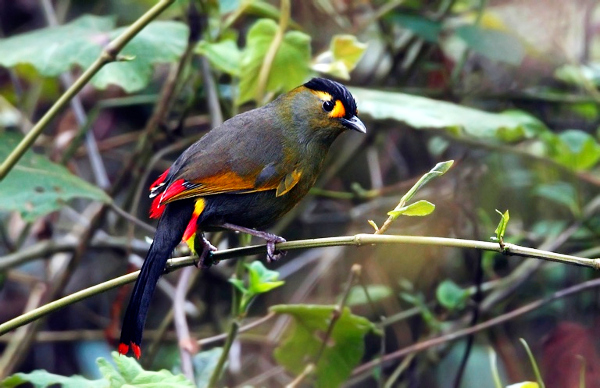The Bugun people baulked when Millo Tasser, a divisional forest officer, first proposed to them the idea of a community reserve in Singchung village in Arunachal Pradesh, back in 2013. The reaction was understandable. The Scheduled Tribe members were worried they would have to give up their land to the forest department and that too without getting any compensation. “In fact, people were angry. They didn’t understand what it would involve and thought they would lose their land rights,” says Nima Glow, a resident of Singchung.
Her village in West Kameng district, located about 130 km from Tezpur in Assam, abuts the Eaglenest Wildlife Sanctuary. The 217 square km forest and the area around it is an ecological hotspot — home to a stunning variety of flora and fauna, such as the famous red panda, the clouded leopard and over 500 bird species. In this profusion, one resident stands out: an olive-green critically endangered bird called Bugun liocichla. Protecting this diminutive bird is crucial because there are just about 20 pairs left in the world, and all of them live in and around Eaglenest.
The Bugun liocichla was first spotted here by astronomer and naturalist Ramana Athreya in 1995 though it would be another decade before he found the bird again, naming it after the Buguns in 2006. The discovery of the first bird species in about half a century in India brought global attention to Eaglenest.
Since then, Athreyahs worked with the Buguns, themselves numbering just about 3,000, to set up ecotourism projects run by locals like Indi Glow, Nima’s husband. But while Eaglenest was a protected sanctuary under the forest department, the area outside it was not. “The Bugun liocichla is found inside the sanctuary but it was first spotted in what is now the conserved area. We realised the area outside the sanctuary is equally diverse and needs to be protected and through this, the locals should benefit too,” says Tasser, who was posted to Eaglenest eight years ago.
He figured that one solution could be setting up a community reserve under the provisions of the Wildlife (Protection) Act of 1972. The area would then be accorded the same legal protection as a wildlife sanctuary. What followed were multiple rounds of discussions with the villagers over the years to explain what this change entailed and, most importantly, letting them know that they would retain the land rights. “Tasser explained that in case the villagers needed to use some of the land for cultivation, they could get it de-reserved through a management committee,” says Naresh Glow, a former MLA and now chief adviser of the community reserve management panel.
Helping Tasser and the department were researchers Nandini Velho and Umesh Srinivasan, who had been doing fieldwork in the region for long. They helped convince the Buguns, collected wildlife data, mapped the area and drew up a plan to manage the reserve.
Finally, the villagers decided to make 17 square km of their land into a community reserve. “It is important for us to protect our water sources and forests. People understand that,” says Naresh Glow. The lives of the Buguns and the bird named after them are inextricably linked, he says.
The plan for the reserve was approved by the state government and in January 2017, the Singchung Bugun Village Community Reserve came into being.
Nine young men and one woman have since been employed to patrol the area.
The committee has systemised extraction of non-timber forest produce.
To economically support the village, ecotourism and a host of adventure activities have been launched near the reserve. The state government has also released funds for habitat improvement and tourism.
In the short time since it came into being, the reserve has scooped up the India Biodiversity Award given jointly by the Centre and the United Nations Development Programme.
Tasser says the reserve has also become something of a model, with new batches of India Forest Service officers visiting Singchung every year to understand how the reserve was created.
And the Buguns seem content. “Our youngsters have more avenues of employment now. The region, which is actually a catchment area for our water source, is now kept clean and protected,” says Indi Glow.
Perhaps the biggest vote of confidence comes from the change in the mindset of the once-apprehensive villagers. “We have seen the benefits. We are now in talks to add another 20 square km of our land to the community reserve,” says Indi Glow.
Source: ET
Image Courtesy: Mongbay
You may also like
-
Trade Connect E-platform For Exports Is Single Window, Fast, Accessible And Transformational: Shri Piyush Goyal
-
Five Successful Years of Pradhan Mantri Kisan Maandhan Yojana (PM-KMY)
-
Global Study by Leading Experts : Swachh Bharat Mission Drives Significant Reductions in Infant Mortality Rates in India
-
India Graphene Engineering and Innovation Centre (IGEIC) Under the Vision of Viksit Bharat@2047 Launched
-
Government Launches Vishvasya-Blockchain Technology Stack
